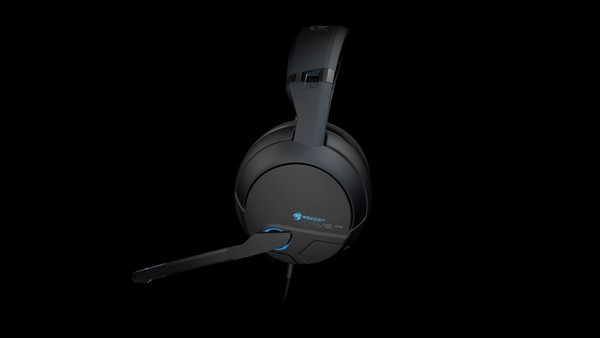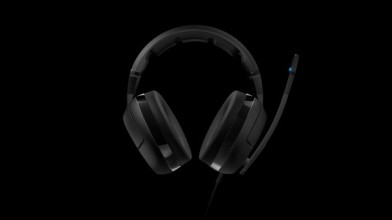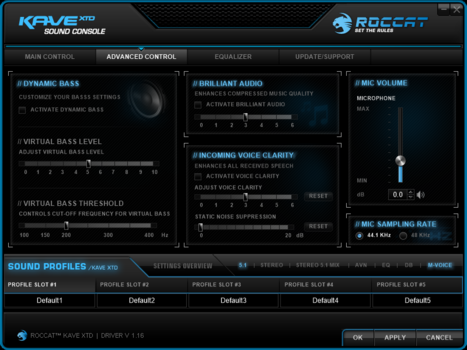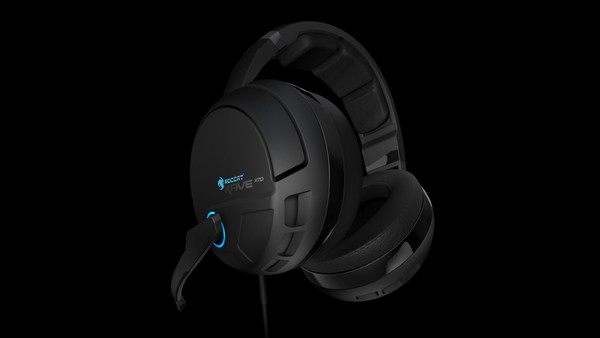The Roccat Kave XTD 5.1 Digital gaming headset comes with one of the best desktop controllers and bundled driver software money can buy. But while the Kave XTD is a control-freak’s dream, it’s not perfect.
Kave XTD Technical Specifications

CENTER/FRONT/REAR DRIVER UNITS
- Frequency response: 20~20.000Hz
- Max. SPL at 1kHz: 115±3dB
- Max. input power: 50mW
- Drive diameter front: 40mm
- Drive diameter rear: 40mm
VIBRATION DRIVER UNITS
- Frequency response: 20~100Hz
- Max. input power: 300mW
- Drive diameter: 30mm
MICROPHONE
- Frequency response: 10~10.000Hz
- Sensitivity at 1kHz: -32±2dB
- Directivity: omni-directional
- Diameter: 4×1.5mm
- Impedance: 2.2 kΩ + 15%
Roccat Kave XTD features and design
The Roccat Kave (pronounced ‘Cave’) is a USB headset equipped with one of the best-designed desktop controllers I’ve ever used. Next to well-designed ear cup controls, I heavily favor desktop-based control modules like the Kave’s, and the excellent ones included with the Razer Tiamat and CM Storm Sirus 5.1 headsets. The Kave XTD controller easily matches or surpasses either of them.

The sleek Kave XTD controller is large and heavy enough to be a very stable edition to your desktop. It’s heavier than the Razer Tiamat controller (which is too light) and a little lighter than the CM Storm Sirus 5.1 controller (which is quite heavy).
The Kave XTD controller handles all of the Kave’s essential functions—you don’t even need its driver software, although you’ll want it to take advantage of even more options and features.
The Kave XTD controller includes the following:

- Volume control knob: A large, stereo-sized knob controls the volume. Press it to mute sound.
- Microphone mute button.
- Phone-answer/end call button
- Dedicated ‘movie’ button for enhanced movie audio
- Dedicated channel button—used in conjunction with the volume control, you can press the Channel button to switch between the 5 sound channels (front, rear, subwoofer, and center) and adjust the levels for each).
- Dedicated Speakers button: The XTD controller has 3.5mm 5.1 speaker outputs so you can connect a 5.1 speaker system to the Kave XTD control module. This enables easy switching between the headset and your sound system.
In addition, the Kave XTD is Bluetooth compatible, so you can pair the Kave XTD with your smartphone and take calls and game at the same time. Taking a call mid-game automatically mutes the game audio.
Rounding out the feature list is an LED-tipped microphone that lights up when it’s muted—a feature I’ve always personally recommended.
While the Kave XTD controller is pretty much all you need for the essentials, Roccat doesn’t stop there. The Kave XTD software provides numerous features for tweaking your soundscape, such as an 11-channel software equalizer and a host of proprietary options, including voice morphing to make your voice sound like a Rubber Duck (among others) — which I confess I used for a few chuckles in a game of Smite or three (with friends).

Most of the proprietary options, however, seem to just be software-controls for cleverly-named (renamed) audio settings to make them sound more enticing.
For example, there’s a ‘Volume Normalizer’ that basically flattens volume levels—which actually kind of counters any equalizer settings you may have, so I didn’t really find a use for it. There’s also the ‘Brilliant Audio’ option that enhances the quality of compressed music playback—which seems to largely serve as an adjustable treble increase (though it did seem to improve clarity somewhat in MP3 playback).
Other features include an adjustable ‘dynamic bass boost’ and an adjustable ‘virtual bass boost’, both of which let you tweak (boost) your bass.
Comfort
The Kave XTD is light and generally comfortable, although not quite in the same league as some of the more comfortable headsets out there, which include the SteelSeries Siberia V2, Astro Gaming A50, and Razer Tiamat. The Roccat Kave’s ear cups are a little cramped, although they do provide a modest measure of passive noise isolation.
Regardless, the Kave XTD as a whole is light, and comfortable enough for extended wear. The ear cups do not rotate 90 degrees for resting around your neck.
Performance
Despite its impressive controller and an array of software-based options, the Kave XTD seems to fall slightly behind competitors in its price range when it comes to sound quality.
Admittedly, it’s hard to put a finger on exactly why. The sound quality is good overall, with decent bass, no distortion, and a rich range of options to fine tune everything. Regardless, the Kave XTD never seemed quite as good to listen to as some of my other favorite headsets, including the Astro Gaming A50 and Razer Tiamat for example.

The overall quality of the Kave XTD seems subtly muted. The Kave’s surround sound performance is adequate, but overall directional audio doesn’t seem as discreet as other headsets I’ve reviewed—despite the Kave’s use of 3 separate, angled drivers in each ear cup (for front, rear, and center audio).
For example, in Left 4 Dead 2 the directional cues are pronounced enough to be functional, but after adjusting independent volume levels and various combinations of settings it just never felt as distinct as other headsets I’ve reviewed.
But a lot of this largely falls to subjective ‘intangibles’—so take it all with a grain of salt. The Kave XTD software provides plenty of audio tweaks, equalizer presets, and an extensive array of options for fine-tuning the XTD output. It may just be a matter of finding the best combination of settings; and one gamer’s audio nirvana can be another gamer’s cacophonous hell.
Overall: 7/10
The Roccat XTD scores top marks in overall design, features, and richly featured software. Comfort is above average as-is general audio performance, although it doesn’t quite reach the top tier of sound quality as some of its high (and higher) end competitors.
